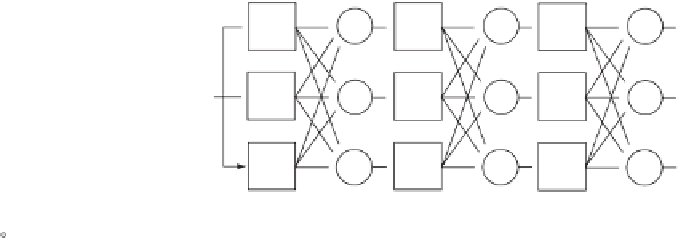Information Technology Reference
In-Depth Information
x1
y1
y1
x1
y1
1 bM
x1
MG
X1
MG
Y1
MG
Z1
MG
x2
y2
x2
y2
x2
y2
Z
1 bM
MG
MG
X2
Y2
MG
Z2
MG
MG
1 bM
X3
MG
Y3
MG
Z3
MG
x3
x3
x3
y3
y3
y3
1 bM
MG = Majority gate
MG
MG = Majority gate
(a)
(b)
Figure
10.2.
Different CTMR configurations. (a) Generic CTMR: multilayer voting;
(b) CTMR with triple voters: smaller granularity.
with a MAJ gate. Figure 10.2a shows a first-order CTMR configuration where the
parallel processing units in each of the three TMR units are NAND gates. Due to
the area and latency overheads associated with this technique, the triplicated units
in the CTMR with a multilayer voting scheme are normally functional units or
logic blocks, not single gates as shown in Figure 10.2a. Since the triplicated
functional units or logic blocks may consist of a large number of gates, their
failure probability is more than individual gates. Hence, the multilevel CTMR
with triple voters as shown in Figure 10.2b may be used to apportion the system
into optimally sized functional units or logic blocks to effectively allow the
architecture to withstand more errors across the triplicated units [14].
10.2.1.3. Triple Interwoven Redundancy (TIR).
The idea of TIR is based
on von Neumann's multiplexing techniques and interwoven redundant logic [15].
A TIR architectural configuration has three times as many gates and interconnects
as compared to the nonredundant network. The interconnections are arranged in
random patterns. Such inherent randomness in the interconnections makes this
structural redundancy technique favorable for the integration of molecular
devices, since the manufacturing method for such devices is most likely to be
stochastic chemical assembly. Figure 10.3 shows a nonredundant half adder and
its corresponding TIR implementation. For a particular interconnect pattern, [16]
shows that the TIR actually works as a TMR configuration, implying that TMR is
a specific implementation of TIR.
10.2.1.4. Multiplexing Techniques.
Structural redundancy-based architec-
tures that can circumvent transient faults can affect both the computation and
communication in nanosystems. Interestingly, von Neumann addressed this issue


















































Search WWH ::

Custom Search